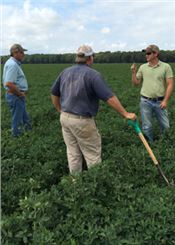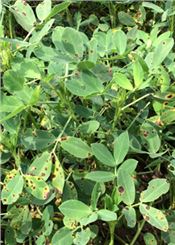|
Lack Of Rain Has Growers Expecting Average Peanuts
STARKVILLE, MISS.
Mississippi farmers planted more peanuts in response to economic factors that made the crop an attractive choice this year, but a lack of rain now has them expecting average yields.
Mississippi has 42,000 acres of peanuts this year, up 45 percent from what was planted in 2014. The U.S. Department of Agriculture estimates 84 percent of the crop is in fair to good condition.
Jason Sarver, Mississippi Agricultural and Forestry Experiment Station researcher and Mississippi State University Extension Service peanut specialist, said two factors convinced producers to plant more peanuts.
“The price of other commodities has gone down, so peanuts look better in comparison,” he said. “The second reason is that the new farm bill is positive for peanut farmers, and that was a real motivation to increase acreage.”
MSU planning budgets estimated peanut profits at about $15 to $20 per acre, which is higher than expected returns for corn and cotton and slightly lower than returns for soybeans.
There are several good reasons for farmers to rotate peanuts with cotton and corn. Peanuts do not host the diseases or nematodes that affect cotton or corn, so planting a field in the legumes for a year reduces these pest pressures.
“Being a legume, peanuts fix their own nitrogen, so they leave a lot of nutrients in the soil for the following season,” Sarver said. “Peanuts are excellent scavengers of phosphorous and potassium, so often a producer can fertilize for cotton or corn one year and grow a peanut crop the next year with only residual fertilizer. In that respect, it’s a fairly cheap crop to grow.”
Producers had difficulty getting the peanut crop planted because of frequent rain and cool weather.
“Peanuts need a higher soil temperate to germinate and emerge than any other crop we grow in the state,” Sarver said. “We had some that stayed in the ground a month this year before they came up.”
Because of the slow start, very few peanut acres had been dug and almost none harvested by the second week of September. Harvest should be underway by the end of the month.
Many of the state’s peanuts are planted in a corridor from Greenwood to south of Tchula through the Delta. These fields have gotten very little rain since early July. Other fields are in northeast and southeast Mississippi.
“We’ve been pretty fortunate compared to the Delta and south Mississippi because we’ve had more favorable rainfall,” said Charlie Stokes, an Extension agronomic crops agent based in Monroe County. “We’ve got a pretty good-looking crop.”
Stokes said peanuts in his area had no real problems with insects, and growers were able to control the disease problems that surfaced.
Brian Williams, Extension agricultural economist, said peanut prices are about the same as last year and down just a bit from 2014.
“As of Sept. 9, the national average for runner peanuts is $424.51 per ton,” he said. “Right now, it appears as if there haven’t been any major movers in the peanut market. We have a large jump in planted acres, but that increase looks like it will be offset by lower projected yields.” ∆

Mississippi State University researcher Jason Sarver, right, examines the condition
of peanuts in a Leflore County, Mississippi, field on Sept. 10, 2015. With him, from left,
is consultant Bruce Pittman and grower Justin Jeffcoat.
Photo by MSU Extension Service/Chad Abbott

These peanuts in Monroe County, Mississippi, on Sept. 9, 2015,
exhibit signs of early leaf spot disease. A lack of rain has produced
an average crop across the state.
Photo by MSU Extension Service/Jason Sarver
|
|